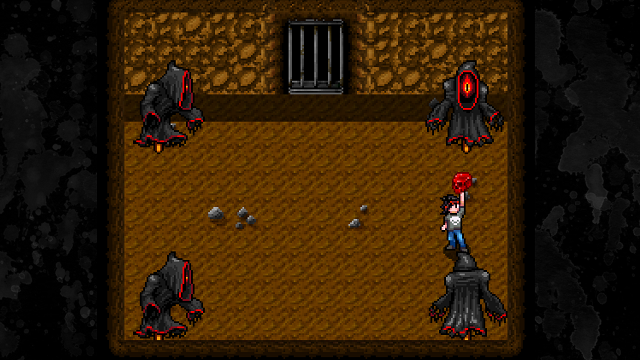
After several hours with Barnyard Intelligence Games’ High Strangeness, one thing is abundantly clear: the game is definitely making a strong effort to earn that title. Indie games featuring old-school graphics might seem all too common nowadays, but High Strangeness is unique in two ways: it was actually Kickstarted back in 2009 and it allows you to switch between both 16- and 8-bit art styles. There are plenty of other features that contribute to the game’s strangeness, as well as a few mechanics that help keep things grounded.
The first thing that will probably make you realize High Strangeness isn’t you average action-adventure game is the story. You play as Boyd, a rather normal dude who stumbles into an inter-dimensional conflict that involves his cat (who knows how to talk), magical crystal skulls, and an army of cloak wearing bad guys. The set-up is definitely quirky, offering a bit of twist on the classic “chosen hero” story that is backed up by consistently humorous writing and likeable characters. Hopefully it can keep it up throughout the adventure.
Unlike the story, much of the core gameplay is quite a bit more typical, though that isn’t necessarily a bad thing. Anyone familiar with 8- or 16-bit action RPGs in the vein of Zelda, Secret of Mana, or Terranigma should feel right at home. Like these classics, High Strangeness focuses on a mixture of combat, exploration, and puzzle solving to offer a varied and challenging experience. Based on what I’ve played so far, it manages to do this rather well, upping the combat and puzzle difficult at a very fair and compelling pace to keep things moving without the game feeling too easy.

Also like Zelda, High Strangeness expands its gameplay through new items and power-ups. Early on, you get a firecracker that acts as a time bomb capable of damaging enemies and breaking down weak walls, CDs that can be thrown to stun enemies, and a magic skull that also stuns enemies, but it does so in an area of effect directly around Boyd. These items, along with some of Boyd’s personal stats, can be upgraded through crystal eyes dropped by enemies, which can be spent at altars located throughout the game. In an interesting odd to a more recent Zelda– A Link Between Worlds to be precise– these items, along with your regular attacks, are powered through a stamina meter that naturally recovers over time.
The aforementioned ability to switch between 8- and 16-bit graphics is where High Strangeness adds its own flavor to this classic genre. The difference between these two styles isn’t just aesthetic, as the core mechanics shift to also match the feel of the games of each respective generation. While in 8-bit, your movements feel much more stiff, as you are restricted to moving up, down, left, or right from tile to tile in an invisible grid. In other words, it feels a lot like the original Zelda. The 16-bit world ditches the grid and lets you freely move diagonally in the more detailed environments. Also, in the more advanced world, combat is much smoother as well, as Boyd is able to attack in multi-hit combos. This mechanic further complicates the game through the use of puzzle elements, pathways, and enemies that can only be interacted with while in the proper dimension.
Visually, it will come as no surprise that High Strangeness strongly adheres to the look of its 8- and 16-bit inspirations; if you were to give Boyd era appropriate attire, his sprite would fit in just fine in Secret of Mana or Chrono Trigger. One minor issue that might come up is the actual look of the environments, though I’m not completely sure. I just completed a rather long stretch of very similar, uninspired looking environments that I was growing rather tired of. However, I also just moved onto the next area and it is quite the radical departure, so I’m optimistic the game will be able to keep the environmental variety coming. Also, there is one thing about the presentation that I find strangely out of place; during some story segments, the game shows hand drawn still images to punctuate parts of the story, but I don’t think they are that well done. The art itself is more decent than bad, but the real problem is that it just feels out of place to me.
I might sound like a broken record, but High Strangeness has also managed to capture the spirit of its inspirations when it comes to music. To put it simply, I love the score in this game. While 16-bit consoles might not have been able to deliver the audio quality we are used to now, many games from that generation were still able to create phenomenal soundtracks through the sheer strength of the compositions. I don’t think High Strangeness will end up achieving the same musical heights as Chrono Trigger, but everything I’ve heard so far has enough variety, mood, and quality to make my ears plenty happy.
So far, High Strangeness is shaping up to be a very interesting game that could very well prove to be another eShop indie gem. Plenty of small developers have made games meant to capture the look and feel of early classics, but Barnyard Intelligence Games seems to be trying to pull off something more than that. With High Strangeness, the developers aren’t just emulating two generations of old school gaming, they are fusing them together in a way that meaningfully affects gameplay in a unique way. Add on top of that an original, quirky premise and a great soundtrack and you have a game that I can’t wait to play more of.
High Strangeness will be available on Wii U on May 6, so expect our full review sometime in the near future.




 ShareThis
ShareThis






